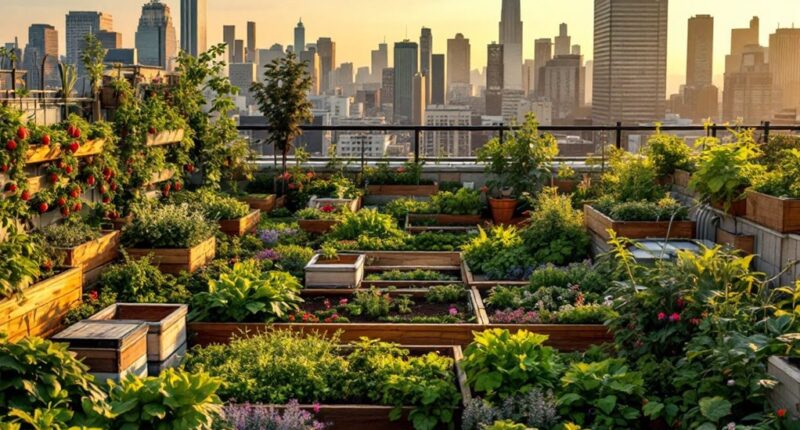Urban farming transforms city spaces into productive food systems through diverse approaches like rooftop gardens, vertical farms, and community plots. This practice reduces food miles while increasing access to fresh produce in urban environments. Innovative technologies such as hydroponics and LED growing systems help overcome challenges like limited space and contaminated soil. Beyond food production, urban farms create green jobs, improve air quality, and foster community connections. The roots of sustainable cities might just be growing in your neighborhood.

Across rooftops, vacant lots, and even balcony railings, a quiet revolution is taking root in cities worldwide. Urban farming—the practice of growing food within metropolitan boundaries—is transforming concrete jungles into productive green spaces that feed communities while healing urban environments. City dwellers are discovering that you don’t need rolling acres to grow dinner; sometimes all it takes is a window box and a bit of ingenuity.
Urban agriculture comes in many flavors, from backyard gardens that supply a single household to ambitious vertical farms that stack growing spaces like agricultural skyscrapers. Community gardens offer shared plots where neighbors can cultivate both vegetables and relationships, while rooftop operations turn unused square footage into productive paradises. These aren’t just hobby gardens—they’re multifunctional solutions to modern urban challenges. Many urban farmers are embracing the principles of permaculture design to create self-sustaining systems that mimic natural ecosystems while maximizing productivity.
The benefits extend far beyond just putting fresh tomatoes on the table. When food grows blocks instead of miles from your plate, the carbon footprint of your dinner shrinks faster than spinach in a hot pan. Green spaces help cities breathe, acting as nature’s air purifiers in environments otherwise dominated by exhaust fumes and air conditioning units. These urban oases also create habitats for beneficial insects and birds—turning food production into ecosystem regeneration. Urban farms also contribute to the ecological balance by cooling air and providing much-needed shade in heat-intensive urban environments.
Of course, city farming isn’t without its hurdles. Urban soil sometimes comes with a side of contaminants, a legacy of industrial pasts. Space remains precious and often expensive, while traversing the labyrinth of city regulations can challenge even the most determined lettuce-grower. Water access can be complicated, and neighbors might raise eyebrows at chicken coops appearing next door.
Fortunately, innovation keeps pace with these challenges. Hydroponic systems grow plants in nutrient-rich water rather than soil. LED lighting enables year-round indoor production. Smart sensors monitor everything from soil moisture to nutrient levels, turning phones into farm management tools. These technologies aren’t just neat gadgets—they’re making urban farming economically viable while creating green jobs and entrepreneurial opportunities in neighborhoods that need them most.
Frequently Asked Questions
How to Deal With Soil Contamination in Urban Areas?
Managing urban soil contamination requires a strategic approach. Testing soil for common pollutants like lead and heavy metals is the first step.
Remediation options include building raised beds with clean soil, adding organic matter to bind contaminants, or using phytoremediation. Urban farmers can also focus on container gardening or growing fruiting crops instead of root vegetables.
Maintaining soil pH above 6.5 reduces metal uptake, while thorough washing of produce provides additional safety.
Can Indoor Urban Farming Be Profitable?
Indoor urban farming can indeed be profitable, with potential profit margins reaching 30-40%. Success hinges on strategic choices: focusing on high-value crops like microgreens and herbs, developing B2B partnerships with restaurants, and leveraging premium pricing for local, pesticide-free produce.
However, profitability faces challenges from high initial investments, energy costs (12-25% of operating budgets), and labor expenses (over 50%). The market is growing steadily, projected to reach $47.2 billion by 2033.
What Are the Best Crops for Limited Urban Spaces?
Limited urban spaces thrive with strategic crop selection. Leafy greens like spinach and kale offer multiple harvests with minimal sunlight requirements.
Root vegetables, especially quick-growing radishes, maximize vertical space in 12-inch containers. Compact tomatoes and peppers yield impressively when grown vertically.
For the truly space-challenged, microgreens and sprouts can transform a windowsill into a productive farm, providing nutritious harvests in as little as 1-2 weeks while requiring minimal resources.
How to Manage Urban Farming in Extreme Weather Conditions?
Managing urban farms during extreme weather requires a multi-layered approach. Farmers can implement vertical systems and controlled environments with high-efficiency LEDs to shield crops from unpredictable conditions. Water management becomes vital—employing rainwater harvesting and precision irrigation conserves resources during droughts.
For temperature extremes, shade cloths and reflective materials combat heat while cold frames protect against frost. Selecting resilient crop varieties that withstand stress completes the protective strategy, ensuring harvests despite Mother Nature’s mood swings.
Are There Grants Available for Urban Farming Initiatives?
Numerous funding opportunities exist for urban farming initiatives at multiple levels. Federal programs like USDA Urban Agriculture grants offer up to $350,000, while state programs vary widely—California awarded $11.67 million in 2023, and Missouri provides up to $10,000 per project.
Private foundations, including Fund-a-Farmer and SARE, contribute substantial support. Additionally, microloans, nutrition programs, and cost-share opportunities help urban farmers overcome financial hurdles. The funding landscape continues to evolve as urban agriculture gains recognition for its community benefits.









